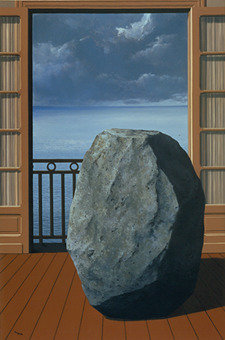Dreamscapes
dal 10/2/2011 al 12/8/2011
Segnalato da
Rene' Magritte
Scott Burton
Paul Delvaux
Max Ernst
Philip Guston
Joan Miro'
Albrecht Durer
Max Klinger
Katharina Fritsch
Janet Cardiff
Francesca Herndon-Consagra
10/2/2011
Dreamscapes
The Pulitzer Foundation, St. Louis
The exhibition incites questions about the act of dreaming - a succession of thoughts, images, sounds or emotions, which the mind experiences during sleep. The artworks on view and their juxtaposition with Tadao Ando's architecture offer new ways to think about the content and purpose of dreams on numerous levels: physiological, psychological, cultural and spiritual.

organized by Francesca Herndon-Consagra
St. Louis – The Pulitzer Foundation for the Arts is pleased to announce Dreamscapes, on view February 11–August 13, 2011. This exhibition incites questions about the act of dreaming—a succession of thoughts, images, sounds or emotions, which the mind experiences during sleep. The artworks on view and their juxtaposition with Tadao Ando's architecture offer new ways to think about the content and purpose of dreams on numerous levels: physiological, psychological, cultural and spiritual.
Dreamscapes is organized by Francesca Herndon-Consagra, senior curator at the Pulitzer, and opens with a public reception on Friday, February 11 from 5pm–9pm.
The concept behind the exhibition began with the Pulitzer’s Watercourt. Its meditative reflecting pool and hewed boulder - Scott Burton’s Rock Settee (1988-89) - create an insular dreamscape in the middle of our city. A glass wall divides the Watercourt from the rest of the Pulitzer building. Similarly, René Magritte’s Le monde invisible (The Invisible World) (1954) depicts an incongruous boulder in a room with open glass doors that frame a waterscape beyond. This painting, along with others depicting boulders floating in air, create a unified yet disorienting space out of both the Entrance Gallery and the adjacent Watercourt. Mimicked is a dream that presents ambiguity between indoor and outdoor spaces, refutes gravity’s powers, and shuffles a mundane object like a boulder into different settings.
The Main Gallery presents a compelling, stylistically diverse group of twentieth-century works. Paintings by Paul Delvaux and Max Ernst appear alongside those by Philip Guston and Joan Miró, offering viewers a range of fantastic visions and disconcerting scenes. Visitors entering the Cube Gallery may experience the sensation of walking into a dreamer’s world when they become immersed in the vibrant red hue of Do Ho Suh’s Staircase, custom-fitted in Korea for this exhibition. The translucent red nylon staircase, disembodied from its original domestic and geographic context, subverts the rational mind’s desire to think logically and make valid judgments about objects in space.
Featured in the Lower Gallery is a selection of images created before 1900 that explore dreaming and dream imagery. Albrecht Dürer’s The Dream of the Doctor (1498–99), Max Klinger’s Glove Cycle (1881), and Katharina Fritsch’s enlarged reproductions of nineteenth-century newspaper illustrations (2007-2008) reveal nightmarish personifications of human fears and desires, all of which prefigure the dream symbolism of Freudian and Jungian psychoanalysis.
Numerous dream experiences occur unexpectedly in the smaller spaces and passageways of the Pulitzer. Visitors are invited to pick up a receiver from one of the telephones located deep within the recesses of the building and listen to the raspy, estranged voice of contemporary artist Janet Cardiff as she recalls a dream she had just moments before waking.
Throughout Dreamscapes, symposia and talks integrating the disciplines of art history, psychoanalysis and neurology will be held on the process of dreaming and dream imagery. In addition, we will investigate questions about the social relevance of art with related community programming. To supplement the installation, the Pulitzer will offer an illustrated publication and an interactive online catalogue.
Through art exhibitions, programs, collaborations and exchanges with other institutions, the Pulitzer aims to foster a deeper understanding and appreciation of art and architecture and is a resource for artists, architects, scholars, students and the general public.
For more information contact Amy Broadway at 314.446.2053 or email her at abroadway@pulitzerarts.org
Image: René Magritte, Le monde invisible (The Invisible World), 1954
Oil on canvas, 77 x 51 5/8 inches
The Menil Collection, Houston (V 615)
Photograph by Hickey-Robertson, Houston
© 2010 C. Herscovici, London / Artists Rights Society (ARS), New York
Opening February 11 from 5pm–9pm
The Pulitzer Foundation
3716 Washington Boulevard, St. Louis USA
open and free to the public Wednesdays from 12 p.m. to 5 p.m.
Saturdays from 10 a.m. to 5 p.m.



